AEG Favorit 5070 W User Manual
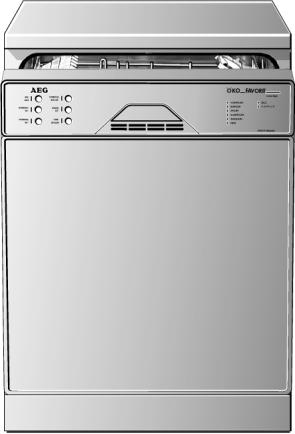
ÖKO_FAVORIT 5070
Dishwasher
User Instructions

Dear customer,
Please read these user instructions carefully.
Please observe the safety instructions on the first few pages of these user instructions! Please keep these user instructions for later reference. Pass them on to any subsequent owner of the appliance.
1 The warning triangle and/or specific words (Warning!, Caution!, Important!) are used to highlight instructions that are important for your safety or for the function of the appliance. It is imperative that these instructions are observed.
0This symbol or numbered instruction steps lead you step by step through the operation of the appliance.
3 |
Next to this symbol you receive additional information and practical |
|
tips on using the appliance. |
2 |
Tips and instructions for the economical and environmentally conscious |
|
use of the appliance are marked with a clover leaf. |
In the event of a malfunction, these operating instructions contain information on how to rectify faults yourself, see the "What to do, if..." section.
If these instructions are insufficient, please contact your AEG Service Force Centre.
In this respect please read the chapter "Service & Spare Parts".
Printed on paper manufactured with environmentally sound processes.
He who thinks ecologically acts accordingly ...
2
|
Contents |
|
CONTENTS |
|
|
Operating instructions . . . . . . . . . . . . . . . . . . . . . . . . . . . . . . . . . . . . |
5 |
|
Safety Instructions |
. . . . . . . . . . . . . . . . . . . . . . . . . . . . . . . . . . . . . . . . . . . . |
5 |
Disposal . . . . . . . . |
. . . . . . . . . . . . . . . . . . . . . . . . . . . . . . . . . . . . . . . . . . . . . . |
7 |
Economical and Ecological Dishwashing . . . . . . . . . . . . . . . . . . . . . . . . . . |
7 |
|
Appliance Features and Control Panel . . . . . . . . . . . . . . . . . . . . . . . . . . . |
8 |
|
Control Panel . . |
. . . . . . . . . . . . . . . . . . . . . . . . . . . . . . . . . . . . . . . . . . . . . |
9 |
Prior to using for the first time . . . . . . . . . . . . . . . . . . . . . . . . . . . . . . . . . |
9 |
|
Adjust the Water Softener . . . . . . . . . . . . . . . . . . . . . . . . . . . . . . . . . . . . . . . |
10 |
|
Filling with Salt for the Water Softener . . . . . . . . . . . . . . . . . . . . . . . . . . . . |
11 |
|
Filling with Rinse Aid . . . . . . . . . . . . . . . . . . . . . . . . . . . . . . . . . . . . . . . . . . . . |
12 |
|
Adjusting Rinse Aid Dosing . . . . . . . . . . . . . . . . . . . . . . . . . . . . . . . . . . . . |
13 |
|
In Daily Use . . . . . . |
. . . . . . . . . . . . . . . . . . . . . . . . . . . . . . . . . . . . . . . . . . . . . |
13 |
Loading Cutlery and Dishes . . . . . . . . . . . . . . . . . . . . . . . . . . . . . . . . . . . . . . |
14 |
|
Loading Cutlery |
. . . . . . . . . . . . . . . . . . . . . . . . . . . . . . . . . . . . . . . . . . . . . |
15 |
Loading Pans, Frying Pans and Large Plates . . . . . . . . . . . . . . . . . . . . . . |
16 |
|
Loading Cups, Glasses and Coffee Services . . . . . . . . . . . . . . . . . . . . . . . |
17 |
|
Adjusting the Height of the Upper Rack . . . . . . . . . . . . . . . . . . . . . . . . . |
18 |
|
Filling with Detergent . . . . . . . . . . . . . . . . . . . . . . . . . . . . . . . . . . . . . . . . . . . |
19 |
|
Bio Wash Programmes and Concentrated Detergents . . . . . . . . . . . . . . |
20 |
|
Selecting the Wash Programme (Programme Table) . . . . . . . . . . . . . . . . . . |
21 |
|
Start the Wash Programme . . . . . . . . . . . . . . . . . . . . . . . . . . . . . . . . . . . . . . |
22 |
|
Changing/Interrupting/Cancelling the Wash Programme . . . . . . . . . . . |
22 |
|
Load Sensing – Sensor Logic . . . . . . . . . . . . . . . . . . . . . . . . . . . . . . . . . . . |
23 |
|
Switching Off the Dishwasher . . . . . . . . . . . . . . . . . . . . . . . . . . . . . . . . . . . . |
23 |
|
Emptying the Dishwasher . . . . . . . . . . . . . . . . . . . . . . . . . . . . . . . . . . . . . |
23 |
|
Care and Cleaning |
. . . . . . . . . . . . . . . . . . . . . . . . . . . . . . . . . . . . . . . . . . . . . |
24 |
Cleaning the Filter . . . . . . . . . . . . . . . . . . . . . . . . . . . . . . . . . . . . . . . . . . . |
24 |
|
What to do, if ... |
. . . . . . . . . . . . . . . . . . . . . . . . . . . . . . . . . . . . . . . . . . . . . . |
26 |
...Error messages . . . |
. . . . . . . . . . . . . . . . . . . . . . . . . . . . . . . . . . . . . . . . . . . . . |
26 |
...there are problems with the operation of the dishwasher. . . . . . . . . . . . |
27 |
|
...the wash results are not satisfactory. . . . . . . . . . . . . . . . . . . . . . . . . . . . . . |
27 |
|
Technical Data . . . |
. . . . . . . . . . . . . . . . . . . . . . . . . . . . . . . . . . . . . . . . . . . . . |
28 |
Notes for Test Institutes . . . . . . . . . . . . . . . . . . . . . . . . . . . . . . . . . . . . . . . . |
29 |
|
|
|
|
3

Contents
Installation and Connection Instructions . . . . . . . . . . . . . . . . |
30 |
Installing the Dishwasher . . . . . . . . . . . . . . . . . . . . . . . . . . . . . . . . . . . . . . . |
30 |
Dishwashers That Can Be Integrated . . . . . . . . . . . . . . . . . . . . . . . . . . . . |
31 |
Built-In Dishwasher . . . . . . . . . . . . . . . . . . . . . . . . . . . . . . . . . . . . . . . . . . |
31 |
Free-Standing Appliances . . . . . . . . . . . . . . . . . . . . . . . . . . . . . . . . . . . . . |
31 |
Connecting the Dishwasher . . . . . . . . . . . . . . . . . . . . . . . . . . . . . . . . . . . . . |
33 |
Water Connection . . . . . . . . . . . . . . . . . . . . . . . . . . . . . . . . . . . . . . . . . . . . . . |
33 |
Permitted water pressure . . . . . . . . . . . . . . . . . . . . . . . . . . . . . . . . . . . . . |
33 |
Connect the inlet hose . . . . . . . . . . . . . . . . . . . . . . . . . . . . . . . . . . . . . . . |
33 |
Water drain . . . . . . . . . . . . . . . . . . . . . . . . . . . . . . . . . . . . . . . . . . . . . . . . . |
34 |
Leak Prevention System . . . . . . . . . . . . . . . . . . . . . . . . . . . . . . . . . . . . . . . |
35 |
Electrical Connection . . . . . . . . . . . . . . . . . . . . . . . . . . . . . . . . . . . . . . . . . . . |
35 |
Connections . . . . . . . . . . . . . . . . . . . . . . . . . . . . . . . . . . . . . . . . . . . . . . . . . . . |
37 |
Service Departments . . . . . . . . . . . . . . . . . . . . . . . . . . . . . . . . . . . . . . |
38 |
Other Countries . . . . . . . . . . . . . . . . . . . . . . . . . . . . . . . . . . . . . . . . . . . . . . . . |
38 |
Guarantee Conditions . . . . . . . . . . . . . . . . . . . . . . . . . . . . . . . . . . . . . |
41 |
Great Britain . . . . . . . . . . . . . . . . . . . . . . . . . . . . . . . . . . . . . . . . . . . . . . . . . . . |
41 |
Other Countries . . . . . . . . . . . . . . . . . . . . . . . . . . . . . . . . . . . . . . . . . . . . . . . . |
42 |
Service & Spare parts . . . . . . . . . . . . . . . . . . . . . . . . . . . . . . . . . . . . . |
43 |
4

OPERATING INSTRUCTIONS
1 Safety Instructions
The safety features of AEG electrical appliances comply with accepted technical standards and the German Appliance Safety Law. Nevertheless, as a manufacturer we consider it our obligation to make you aware of the following safety information:
Installation, Connection and Placing into Operation
•The dishwasher may only be transported upright.
•Check the dishwasher for transport damage. Under no circumstance should a damaged appliance be connected up. In the event of damage, please contact your retailer.
•Before installing the appliance, ensure that the nominal voltage and type of current specified on the rating plate are the same as those used at the place of installation. Please also refer to the type plate for the type of fuse to be used.
•You will find details on how to correctly install and connect up your dishwasher in the "Installation" section. Adaptors / connectors and extension cables must not be used.
Child Safety
•This appliance is designed to be operated by adults. Children should not be allowed to tamper with the controls or play with the product.
•Keep all packaging away from children.
•Keep all detergents in a safe place out of children’s reach.
•The water in your dishwasher is not suitable for drinking. If there are still remnants of detergent in the appliance, there is risk of burns!
•When disposing of an old appliance, cut off the power supply cable and remove any door catches, to prevent young children being trapped inside.
General safety
•Repairs to the dishwasher may only be performed by qualified service engineers. Improper repairs can give rise to significant hazards for the user. If your appliance needs repairing, please contact your local AEG Service Force Centre.
5

Operating instructions
•Never use the dishwasher if the mains cable, inlet / drain hose are damaged or the control panel, work surface or plinth area are damaged such that internal components of the appliance are openly accessible.
•If the mains lead is damaged, or is to be replaced for a longer lead, the cable (obtainable from AEG Service Force) must be changed by a service engineer authorised by AEG.
•Never unplug the appliance by pulling on the cable, always pull on the plug.
•Additions or modifications to the dishwasher are not permitted for safety reasons.
•Ensure that the door of the dishwasher is always closed, except during loading and emptying. By this means you will avoid anyone tripping over the open door and hurting themselves.
•Long bladed knives stored in an upright position are a potential hazard.
•Long and/or sharp items of cutlery such as carving knives must be positioned horizontaly in the upper basket.
•When finished loading or unloading, close the door as an open door can be a hazard.
Correct Use
•Only wash household dishes with the dishwasher. If the appliance is used for purposes other than those intended or used incorrectly, no liability will be accepted by the manufacturer for any damage that may be caused.
•Only use detergents specifically designed for use in domestic dishwashers.
•Do not put solvents in the dishwasher. There is a risk of an explosion!
•The leak prevention system provides reliable protection from damage due to water leaks. For this system to function the following prerequisites must be met:
–The appliance must remain connected to the mains even when it is switched off.
–The dishwasher must be correctly installed.
–Always shut off the water supply at the tap when the dishwasher is not to be used for longer periods, e.g. when you are away on holiday.
•Do not sit or stand on the open door, the appliance may tip over.
6

Operating instructions
•In the event of a fault, shut off the water supply at the tap, then switch off the appliance and unplug. In the case of a permanent connection: remove the fuse.
2 Disposal
Disposing of the Packaging Material
Dispose of the dishwasher packaging material correctly. All the packaging materials used are harmless to the environment and can be recycled.
• Plastic parts are marked with standard international abbreviations:
– >PE< |
for polyethylene, e.g. sheet wrapping material |
– >PS< |
for polystyrene, e.g. padding material (always CFC-free) |
– >POM< |
for polyoxymethylene, e.g. plastic clips |
•Cardboard packaging is manufactured from recycled paper and should be deposited in the waste paper collection for recycling.
Disposal of Old Appliances
When disposing of old appliances, remove the plug and ensure that any locks or catches are removed to prevent young children becoming trapped inside.
Use an authorised disposal site.
2Economical and Ecological Dishwashing
•Ensure that the water softener is correctly adjusted.
•Do not pre-rinse dishes under running water.
•When you wash a small load, the load sensor calculates the amount of water necessary and shortens the programme. It is more economical to always wash with a full load.
•Select the wash programme to suit the nature and degree of the soiling on the dishes.
•Do not use more detergent, special salt or rinse aid than is recommended in these operating instructions and by the detergent manufacturer.
7
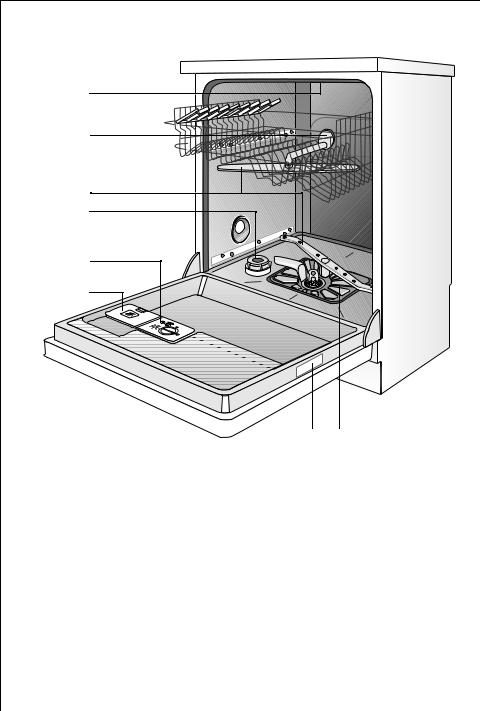
Operating instructions
Appliance Features and Control Panel |
|
Top Spray |
|
Nozzle |
|
Rubber Seal for |
|
Connecting the |
|
Water Feed to |
|
the Upper Spray |
|
Arm |
|
Spray Arms |
|
Container for |
|
Salt |
|
Container |
|
for Rinse Aid |
|
Detergent |
|
Dispenser |
|
Rating |
Filters |
Plate |
|
8 |
|

|
|
|
|
|
|
|
|
Operating instructions |
|||||
|
Control Panel |
|
|
|
|
|
|
|
|
||||
|
Function |
|
Softener |
|
|
|
|
|
|
|
|
||
|
Button |
|
Button |
Door Handle |
|
|
|
Indicators |
|||||
|
|
|
|
|
|
|
|
|
|
|
|
|
|
|
|
|
|
|
|
|
|
|
|
|
|
|
|
|
|
|
|
|
|
|
|
|
|
|
|
|
|
|
|
|
|
|
|
|
|
|
|
|
|
|
|
|
|
|
|
|
|
|
|
|
|
|
|
|
|
|
|
|
|
|
|
|
|
|
|
|
|
|
|
|
|
|
|
|
|
|
|
|
|
|
|
|
|
|
|
|
|
|
|
|
|
|
|
|
|
|
|
|
|
|
|
|
|
|
|
|
|
|
|
|
|
|
|
|
|
|
|
|
|
|
|
|
|
|
|
Control Field |
Display for the Individual |
|
Wash Programme Steps |
The Control Field comprises the ON/OFF button and the programme buttons with LED indicators.
Softener and Function Button: In addition to the wash programme marked, the dishwasher's water softener is adjusted using a combination of these buttons.
The Indicators have the following meanings:
SALT |
Refill with salt |
RINSE AID |
Refill with rinse aid |
|
|
Prior to using for the first time
Prior to using for the first time, remove all the clips with which the dish racks are secured for transport.
Then perform the following steps: 0 1. Adjust the water softener
2.Filling with Special Salt for the Water Softener
3.Filling with Rinse Aid
9

Operating instructions
Adjust the Water Softener
|
To avoid the scale deposits on the dishes and in the dishwasher, the |
|
dishes must be washed with soft, i.e. low lime content, water. The dish- |
|
washer therefore has a built-in water softener, in which tap water from |
|
a hardness of 4 °d (German degree) is softened with the aid of special |
|
salt. |
3 |
You water supplier will be able to inform you on the hardness and |
|
hardness range of the water in your area. |
0Adjust the water softener to the setting that corresponds to the hardness of the water in your area. The water softener can be adjusted in 10 steps.
|
Water Hardness |
|
Adjust |
Number of |
||
in °d1) |
|
in ppm 2) |
Range |
to Hardness Setting |
Flashes |
|
41-50 |
|
730-900 |
|
|
9 |
9 |
|
|
|
||||
35-40 |
|
630-720 |
|
|
8 |
8 |
31-34 |
|
550-620 |
|
IV |
7 |
7 |
27-30 |
|
480-540 |
|
|
6 |
6 |
23-26 |
|
410-470 |
|
|
5 |
5 |
19-22 |
|
330-400 |
|
III |
4 |
4 |
15-18 |
|
260-320 |
|
3* |
3 |
|
|
|
|
||||
|
|
|
|
|
|
|
11-14 |
|
190-250 |
|
II |
2 |
2 |
4-10 |
|
70-180 |
|
I/II |
1 |
1 |
under 4 |
|
under 70 |
|
I |
0 |
10 |
|
|
no salt necessary |
||||
|
|
|
|
|
|
|
|
|
|
|
|
|
|
1)(°d) German degree, measure of the hardness of water 2)(ppm) Parts Per Million
*factory setting
0 1. The dishwasher must be switched off.
2.Press the function and water softener buttons simultaneously and keep them pressed.
3.In addition press the ON/OFF switch.
The LED indicators for the function and water softener buttons flash.
4.Press the softener button again.
The water softener button indicator starts to flash.
–The number of flashes corresponds to the hardness setting. (Exception: hardness setting 0 is indicated by 10 flashes).
–The sequence of flashes is repeated after a 5 second pause.
10
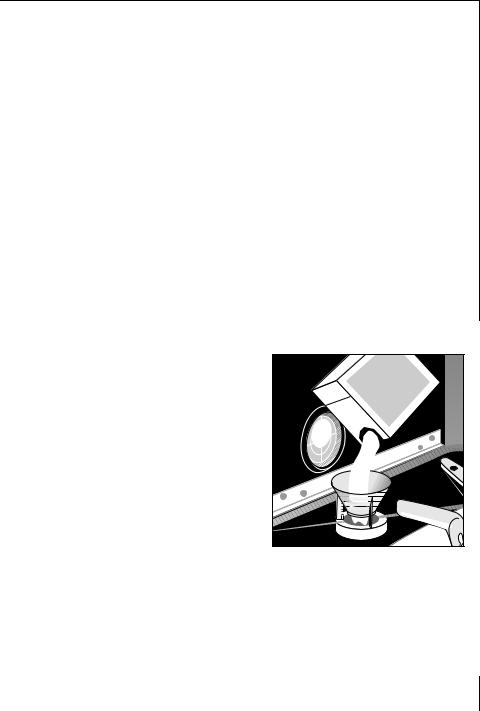
Operating instructions
5.Pressing the water softener button increases the hardness setting by 1.
(Exception: hardness setting 0 follows hardness setting 9).
6.When the hardness setting is correct, press the ON/OFF switch. The hardness setting is then saved.
Filling with Salt for the Water Softener
1 |
Use only special salt for dishwashers. Never fill the salt container with |
|
any another type of salt (e.g. culinary salt) or dishwasher detergent, as |
this would irreparably damage the water softener.
Prior to filling with salt, please check each time that you really do have a packet of dishwasher salt in your hand.
Fill with dishwasher salt:
–Prior to using the dishwasher for the first time
–When the SALT indicator on the control panel is illuminated.
3 |
If the water hardness in your area is less than 4 °d, you do not need to |
|
use dishwasher salt. |
0 1. Open the door, remove the lower rack.
2.Undo the lid on the salt container by turning it anticlockwise.
3.When using for the first time: fill the salt container with water.
4.Place the funnel supplied on the container opening.
Fill the container with salt through the funnel; the capacity of the container is approx. 1.0-1.5 kg depending on the grain size. Do not overfill the salt container with salt.
SALE |
SALT |
SALZ |
SEL |
3 The water expelled by filling the salt container with special salt runs out of the salt container onto the base of the washing compartment. This is not a cause for concern, the water will be pumped out at the start of the next wash programme.
5.Clean any salt remnants on the container opening.
6.Turn the lid clockwise to the stop, otherwise dishwasher salt will leak into the wash water. Dull glasses may result.
11
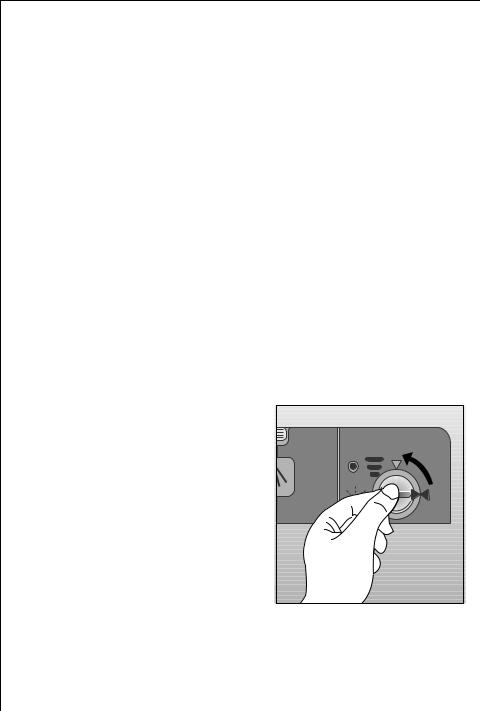
Operating instructions
7.If you are not going to wash your dishes immediately, you should run the PRE WASH programme. This will wash away salt water that has run out of the container and any grains of salt that have been spilt.
3 Depending on the size of the salt grains, it can take several hours for the salt to dissolve in the water and for the SALT indicator to extinguish.
The setting of the water softener and thus the consumption of salt are dependent on the hardness of the local water.
Filling with Rinse Aid
|
Rinse aid is automatically added during the last rinse, ensuring thor- |
|
ough rinsing, spot and streak free drying. |
1 |
Only use rinse aid specifically designed for domestic dishwashers. Never |
|
fill the rinse aid container with any other substance as this would dam- |
age the appliance.
Fill with rinse aid:
–Prior to using the dishwasher for the first time
–When the RINSE AID indicator on the control panel is illuminated.
The rinse aid container is on the inside of the dishwasher door.
0 1. Open the door
2. Turn the lid of the container ¼ of a turn anticlockwise and remove.
12
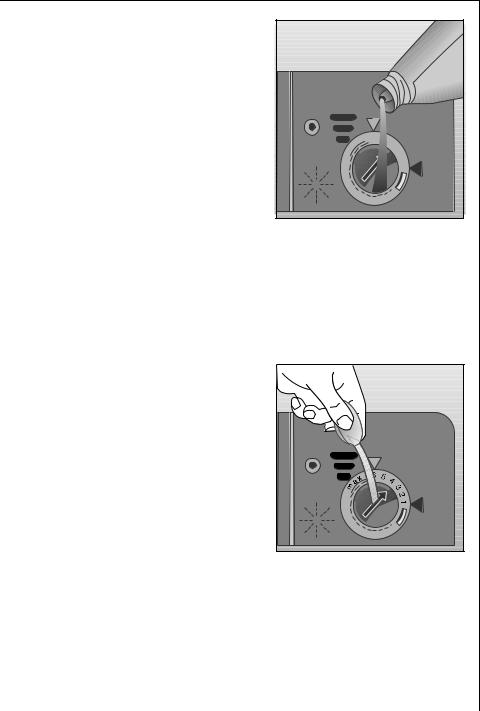
Operating instructions
3.Fill with rinse aid, up to the broken line (maximum); this line corresponds to a quantity of approx. 150 ml
4.Replace the lid and tighten by turning clockwise.
5.If rinse aid has been spilt, wipe up with a cloth. Otherwise there will be foaming during the washing.
|
x |
6 |
5 |
4 |
|
|
|||
m |
a |
|
|
|
|
|
3 |
||
|
|
|
||
|
|
|
2 |
|
|
|
|
|
1 |
|
Adjusting Rinse Aid Dosing |
3 |
The dose should be adjusted according to the finish and drying results |
|
obtained. The dose is factory set at 4, and can adjusted from 1 to 6. |
Gradually increase the dose if there are drops of water or lime spots on the dishes after washing. Reduce if it there are sticky whitish streaks on the dishes.
0 1. Turn the lid of the container ¼ of a turn anticlockwise and
remove.
2. Adjust the dose setting with a tea spoon.
3. Replace the lid and tighten by turning clockwise.
4. If rinse aid has run out, wipe up with a cloth.
In Daily Use
•Check the salt and rinse aid levels.
•Load cutlery and dishes into the dishwasher
•Fill with dishwasher detergent
•Select a wash programme suitable for the cutlery and dishes
•Start the wash programme
13

Operating instructions
Loading Cutlery and Dishes
1 |
Sponges, household cloths and any object that can absorb water should |
|
|
not be washed in the dishwasher. |
|
|
|
|
|
For washing in the dishwasher the following cutlery/dishes |
|
|
are not suitable: |
are of limited suitability: |
|
||
|
• Cutlery with wooden, horn, |
• Only wash stoneware in the dishwasher if it |
|
china or mother of pearl handles |
is specifically marked as being dishwasher- |
|
• Plastic items that are not heat |
safe by the manufacturer. |
|
resistant |
• Glazed patterns may fade if machine |
|
• Older cutlery with glued parts that |
washed frequently. |
|
is not temperature resistant |
• Silver and aluminium parts have a tendency |
|
• Bonded cutlery items or dishes |
to discolour during washing. Left-overs, e.g. |
|
• Pewter or copper items |
egg white, egg yolk and mustard often |
|
cause discolouring and staining on silver. |
|
|
• Lead crystal glass |
|
|
Therefore always clean left-overs from silver |
|
|
• Steel items subject to rusting |
|
|
immediately, if it is not to be washed |
|
|
• Wooden platters |
straight after use. |
|
• Items made from synthetic fibres |
• Some types of glass can become dull after a |
|
|
large number of washes. |
|
|
|
•Before loading the dishes, you should:
–Remove all scraps of food.
–Soften remnants of burnt food in pans.
•When loading the dishes and cutlery, please note:
–Dishes and cutlery must not impede the rotation of the spray arms.
–Load hollow items such as cups, glasses, pans, etc. with the opening downwards so that water cannot collect in the container or a deep base.
–Dishes and items of cutlery must not lie inside one another, or cover each other
–To avoid damage to glasses, they must not touch
–Do not lay small objects (e.g. lids) in the cutlery rack
14
